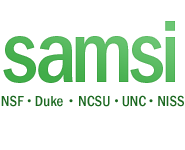Program on Mathematical and Statistical Ecology Working Group - Network Models
Group leaders: Lou Gross, Jay Ver Hoef and Mevin Hooten
Ecological data are often encapsulated as modular units, whether they are genes, individuals, species, communities, habitats, or ecosystem components, in both space and time. Network analysis is an interdisciplinary approach to modeling the modular units through their connectivity. In the mathematical language of graph theory (Lauritzen 1996), the ecological units are called nodes and their connections are termed edges. Mathematical and statistical methods range from describing network (graph) structures (Rayfield et al. 2011) to imposing deterministic and random functions on nodes, edges, or both (Lauritzen 1996). Diverse areas in ecology use network models, including dispersal (Baskett et al. 2007), habitat connectivity and the design of reserves (Baskett et al. 2007, Fall et al. 2007, James et al. 2005), landscape genetics (Naujokaitis-Lewis et al. 2013), food webs (Pascual et al. 2006), and streams and rivers (Ver Hoef and Peterson 2006, 2010, Peterson et al. 2013), to name a few. Network models have been made temporally explicit and dynamic (Fletcher et al. 2011, Fortuna et al. 2011) and spatially explicit (James et al. 2005, Dale and Fortin 2010, Peterson et al. 2013). Often, scientific disciplines develop their own approaches to network data, yet much can be gained by importing those models into ecology (Fletcher et al. 2011, Fortuna et al. 2011). In ecology, least-cost path modeling (Beier et al. 2009) and circuit theory (McRae et al. 2008, Hanks and Hooten 2013) have proven useful and popular. This working group aims to take a broad review and synthesis of network models in ecology, linking them through graph theory and describing their basic properties and objectives. Dominant approaches can be mathematical or statistical, they might be descriptive, simulation-based, or inferential from models. The best approach may depend on the ecological objectives. After a basic review, the goal of the working group will be to identify potential areas for further model development. This working group will work closely with other working groups to find specific instances for research. For example, there are new approaches in molecular ecological network analyses (Deng et al. 2012), and this working group will cooperate with the bioinformatics program at SAMSI. Additionally, there are clear linkages to ecosystems, species assemblages, and many other topics in ecology that can use further research from the perspective of network models.
References:
Baskett, M., Weitz, J., and Levin, S.A. (2007) "The evolution of dispersal in reserve networks." American Naturalist, 170, 59 - 78.
Beier, P, Majka, D.R., and Newell, S.L. (2009) "Uncertainty analysis of least-cost modeling for designing wildlife linkages," Ecological Applications, 19, 2067 – 2077.
Blonder, B., Wey, T.W., Dornhaus, A., James, R. and Sih, A. (2012). Temporal dynamics and network analysis. Methods in Ecology and Evolution, 3, 958 - 972.
Dale, M.R.T. & Fortin, M.-J. (2010). "From graphs to spatial graphs," Annu. Rev. Ecol. Evol. Syst., 41, 21 – 38.
Deng, Y., Jiang, Y.H., Yang, Y., He, Z., Lou, F. and Zhou, J. (2012). "Molecular ecological network analyses," BMC Bioinformatics doi:10.1186/1471-2105-13-113.
Fall, A., Fortin, M.-J., Manseau, M. & O’Brien, D. (2007). "Spatial graphs: Principles and applications for habitat connectivity," Ecosystems, 10, 448–461.
Fletcher, R.J., Acevedo, M.A., Reichert, B.E., Pias, K.E., and Kitchens, W.M. (2011) "Social network models predict movement and connectivity in ecological landscapes," PNAS, 108, 19282 - 19287.
Fortuna, M.A, Bonachela, J.A. and Levin, S.A. (2011) "Evolution of a modular software network," PNAS, 108, 19985 - 19989.
Hanks, E.M. and M.B. Hooten. (2013). Circuit theory and model-based inference for landscape connectivity. Journal of the American Statistical Association, 108: 22-33.
James, P., B. Rayfield, A. Fall, M.-J. Fortin and G. Farley. (2005) Reserve network design combining spatial graph theory and species spatial requirements," Geomatica, 59, 121-129.
Lauritzen, S.L. (1996) Graphical Models. Oxford.
McRae, B.H., Dickson, B.G, Keith, T.H., and Shah, V.B. 2008. Using circuit theory to model connectivity in ecology, evolution, and conservation.
Naujokaitis-Lewis, I., Y. Rico, J. Lovell, M.-J. Fortin, and M. Murphy. (2013) "Implications of incomplete networks on estimation of landscape genetic connectivity," Conservation Genetics, 14, 287 - 298.
Pascual, M., Dunne, J.A. and Levin, S.A. (2006) "Challenge for the future: Integrating ecological structure and dynamics," in Ecological Networks: Linking Structure to Dynamics in Food Webs, Pascual, M. and Dunne, J.A. (eds.), 351 - 371.
Peterson, E.E., J.M. Ver Hoef, D.J. Isaak, J.A. Falke, M.-J. Fortin, C. Jordan, K. McNyset, P. Monestiez, A.S. Ruesch, A. Sengupta, N. Som, A. Steel, D.M. Theobald, C.E. Torgersen, S.J. Wenger. (2013) "Modeling dendritic ecological networks in space: An integrated network perspective," Ecology Letters, 16, 707-719.
Rayfield, B., M.-J. Fortin and A. Fall. (2011) "Connectivity for conservation: A framework to classify network measures," Ecology, 92, 847 - 858.
Ver Hoef, J.M., Peterson, E., and Theobald, D. (2006) "Spatial statistical models that use flow and stream distance," Environmental and Ecological Statistics, 13, 449 – 464.
Ver Hoef, J.M. and Peterson, E.E. (2010) "A moving average approach for spatial statistical models of stream networks (with discussion)," Journal of the American Statistical Association, 105, 6 – 18. Rejoinder pgs. 22 – 24.
Return to Ecology Program Home Page
